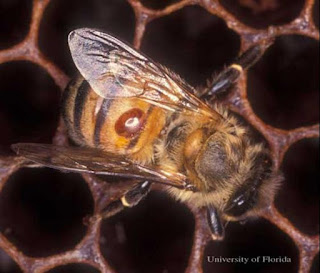Litinsects #47: Varroa Mites
Month of Mites, Part 3
We are now onto some mites that are kind of a bummer: VARROA MITES. These are external parasites of honey bees and they are capable of massive damage to hives. Let’s start with the basics:
 |
| © Scott Bauer |
- Varroa destructor mites are 1-2 mm in size, usually wider than they are long. They are flattened to fit between the abdominal plates of bees, where they feed
- The mites puncture the body and feed on the body fat tissues of larval, pupal, and adult bees. They reduce bee life span and leave hosts weakened with wounds that may be susceptible to other infections
- Varroa is also a VECTOR for numerous viruses that have a negative effect on bees including deformed wing virus
- Although they now have an almost global distribution, these parasites are native to Asia and Western honey bees (Apis mellifera) are not actually their native hosts! Some Asian honey bees (the natural hosts) are believed to have developed some resistance to the mites but Apis mellifera are pretty much defenseless against them
- Relative to host body size, Varroa is actually a pretty large ectoparasite!
 |
| © James Castner |
Now I’ll explain their life cycle:
While adult Varroa mites can feed on any life stage of honey bees, the mites can only reproduce on bee brood (immature stages). Honey bee larvae develop in capped hexagonal brood cells. An adult female mite (either one already present in the hive or one that hitched a ride from a different colony) drops off the adult bee once it is ready to lay eggs and sneakily enters a brood cell before it gets capped. There it hides. Once the cell is capped, this FOUNDRESS mite starts feeding on the developing bee larva and begins laying eggs. The first egg is always male and all the rest are female. About a week after hatching, the offspring are now adults and the siblings mate with one another. The male will die shortly after mating, never leaving the brood cell. It is the females that exit the cell with the adult bee, a new generation that is free to enter more brood cells or hitch rides to other colonies to continue the cycle.
As you can imagine, mite populations can grow very quickly and can do some pretty serious damage to a hive!
Comments
Post a Comment